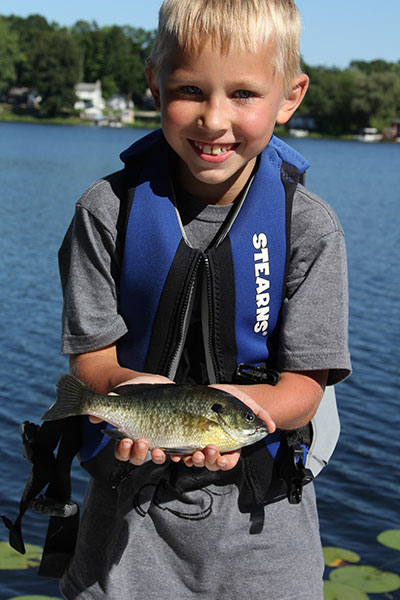By Chuck Powell
 Merrick Powell with a nice bluegill.Dad
can we go fishing today?
Merrick Powell with a nice bluegill.Dad
can we go fishing today?
Thats something thats said often around my household this summer.
Merrick Powell shows off a nice Michiana bluegill he caught while fishing with his dad last week. Bluegill fishing remains good through late summer.
It doesnt take a lot of coaxing for me to want to go. Besides, what better way to keep kids occupied and out of trouble than spending a day bluegill fishing with them?
Im amazed at how many anglers stop panfishing during the dog days of the summer. The fish still have to eat and will if you spend time looking for them.
Its a lot easier if you have a quality sonar graph. When programmed properly, it will show you large balls of bluegill suspended just off weed edges. If the school moves, you can relocate them with the electronics.
Of course, time on the water helps, too. My experiences of fishing bass tournaments throughout Michiana have allowed me to keep tabs on the transitional movement of bluegills, beginning with when they start leaving their beds in late June.
After the initial spawn, most keeper-size bluegills move out to the deep edges of weed beds.
Our lakes typically remain clear, so you can ease along the edges of main-lake weed beds and see bluegills schooling beneath the surface, especially if youre wearing polarized sunglasses.
The points and inside turns of a weed bed are often the best places to find small concentrations of bluegills, but Ive seen them shallow as well.
In fact, two weeks ago on Pipestone Lake, I saw large groups of bluegill sitting on beds in less than two feet of water! They were either late spawners or fish that spawned earlier in the year and spawned again. Bluegill will do that at times.
All you need is basic gear to catch them, beginning with either spincast or spinning gear spooled with 4- to 6-pound line. I favor Vicious fluorocarbon because it has nearly the same light refraction rate as water, which helps it disappear once it is beneath the surface. Add a slip bobber and a small light-wire Aberdeen No. 8 to No. 10 bronze hook, a split shot if youre fishing deeper water, and youre ready to go. Add just enough weight to get your bait to the desired depth.
I start by setting the slip bobber between 6 and 8 feet and will adjust as I see fit. For bait, I prefer red wigglers, red worms, and leaf worms, but I only hook them once time in the middle. This allows the worm freedom of movement and creates the most action.
Either drift or use an electric motor to troll slowly along the outside weed edge, casting close to it or any irregular features in the grass, such as points, openings along the edge, or even a denser cluster of weeds. I especially look for the openings or sandy spots separating the weed bed, or where two different species of weed meet together.
When you do a catch a keeper-size bluegill let down the anchor and continue to fish the area until the action slows. Keep track of the areas where you are successful, as you can revisit these and they will produce time and again throughout the day and summer.
Sound simple? Thats because it is and one cant ask for a better way to spend the day with the family.
And to top it off, youll get a nice mess of bluegills for the family to enjoy at the dinner table.